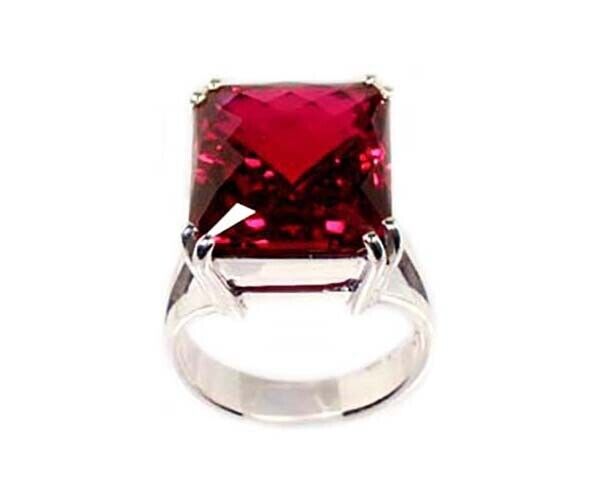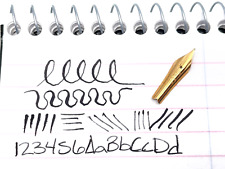When you click on links to various merchants on this site and make a purchase, this can result in this site earning a commission. Affiliate programs and affiliations include, but are not limited to, the eBay Partner Network.
Handcrafted Genuine Natural Nineteen Carat Red Topaz Semi-Precious Gemstone. Contemporary High Quality Sterling Silver Ring (Size 7 – Resizing Available).
ORIGIN: The Ural Mountains, Siberia.
CLASSIFICATION: Bright Red Topaz Emerald Cut Checkerboard Faceted Semi-Precious Gemstone.
SIZE: Length: 17mm. Width: 15mm. Depth: 9mm (thickness). All measurements are approximate.
APPROXIMATE WEIGHT: 18 carats.
DETAIL: In Rome and the Early Medieval world, topaz was associated with Apollo and Jupiter (Zeus to the ancient Greeks), as Topaz was associated with the sun, and both Apollo and Jupiter were solar deities. Both Julius Caesar and his heir Octavian Augustus held Apollo in special reverence. Augustus credited Apollo with his victory of Marc Antony, and erected a magnificent temple to Apollo at Actium overlooking the site of the famous naval battle, as well as an even grander temple on the Palatine in Rome. In the Middle Ages it was believed that a topaz mounted in gold and worn around the neck would dispel enchantments and ward off death. Topaz was also used to treat medical ailments. Topaz powdered and drunk in wine was believed to cure asthma, insomnia, burns and hemorrhages.
Here’s a magnificent, sparkling, vibrantly hued red topaz semi-precious gemstone from the Ural Mountains. The gemstone was hand crafted and faceted by an artisan, part of a centuries-long heritage renown for the production of the elaborate gemstones and jewelry of the Czars of Medieval, Renaissance, and Victorian Russia. Gorgeous and vividly hued, this striking semi-precious gemstone is of very high quality and possesses breathtaking luster. It has been hand cut into a sparkling, brilliant, faceted emerald cut, checkerboard faceted semi-precious gemstone with lots of flash and depth. As you can see, this is an exceptionally good quality gemstone. Certainly to the eye it is nothing less than perfect, it is truly a beautiful, sumptuous, and regal-sized semi-precious gemstone.
Though both pink and red topaz occur naturally in Siberia, it generally tends to be a bit lighter in shade than is the case with this specimen. So I suspect that it’s likely (though not certain) that it was heat-treated. Under magnification the gemstone shows the unmistakable characteristics of having been hand crafted. The coarseness of the handcrafted finish is considered appealing to most gemstone collectors, and is not considered a detriment, or to detract from the value of a gemstone. These characteristics are not only expected of hand-finished gemstones, most serious collectors consider such gemstones more desirable, possessed of greater character and uniqueness when compared to today's cookie-cutter mass-produced machine-faceted gemstones.
Unlike today’s computer controlled machine produced gemstones that approach flawlessness in a perfect finish, the cut and finish of a handcrafted gemstone such as this is the cultural legacy passed onwards by artisans who lived centuries ago. The setting is of contemporary origin. It is a high quality setting constructed of solid sterling silver. We do have the ability to have the ring sent out for resizing if requested. Additionally, if preferred, similar mountings are also available in 14kt solid gold. This gemstone has great luster and sparkle, and to the eye is completely transparent, but one cannot say with absolute certainty that it is absolutely flawless. True, any blemishes it possesses are not visible to the naked eye, and even in the accompanying photo enlargements here (or under a jeweler’s loupe) there are no discernible flaws.
However we hesitate to use the word “flawless”, as sooner or later blemishes will show up at higher levels of magnification with almost every natural gemstone. An absolutely flawless gemstone is very rare in nature (and usually turns out to be synthetic). However the gemstone can be characterized at a minimum, to use trade jargon, as "eye clean". To the eye it is indeed flawless, nonetheless close examination with a jeweler’s loupe will however reveal occasional slight irregularities in the faceting and finish. Naturally these characteristics are expected of hand-finished gemstones. However for most, the unique nature and character of hand-crafted gemstones such as this more than makes up for imperfect finishes and minute blemishes which by and large, are only noticed under high magnification
HISTORY OF TOPAZ: It is believed that topaz was known during the early Bronze Age, as the mining of topaz is strongly associated with tin mining, a mineral needed to create bronze (an alloy of copper and tin). Archaeologists are certain that the people in the Middle-Eastern Bronze Age would have known about this gemstone. However the first historical descriptions of topaz were from the classical Mediterranean. The origin of topaz in the ancient Mediterranean was a small island in the Red Sea known as “Topazion”, a Greek term meaning “to guess”. In Arabic the same term means “"the subject of the search". This reflects the fact that the island was typically obscured by fog, making it difficult for early navigators to find. Typically yellow, topaz in the ancient world was held as a talisman to protect against evil and was used to treat many different physical ailments including asthma.
The Greeks and Romans greatly valued topaz as a gemstone, even believing that the gemstone would improve the wearer’s eyesight. Ancient Romans also credited topaz with preventing sickness of the chest and it was also used to treat abdominal pain. The ancient Greeks believed topaz would give great strength to whomsoever wore the stone, and was also worn as an amulet to ward off enchantment (“spells” or “curses”). The ancient Greeks also believed that wearing topaz would dispel sadness and strengthen the wearer’s intellect. There are also frequent references from ancient Greek sources which claim that wearing topaz rendered the wearer invisible.
In Rome and the Early Medieval world, topaz was associated with Apollo and/or Jupiter, as Topaz was associated with the sun, and both Jupiter and Apollo were solar deities. Both Julius Caesar and his heir Octavian Augustus held Apollo in special reverence. Augustus credited Apollo with his victory over Marc Antony, and erected a magnificent temple to Apollo at Actium overlooking the site of the famous naval battle, as well as an even grander temple on the Palatine in Rome. The gemstone was also described by the first century Roman historian and naturalist “Pliny the Elder”.
There are also many biblical references to "topaz". Topaz was one of the twelve stones selected by Aaron for his priestly breastplate, representing the twelve tribes of ancient Israel. He placed it there as the second stone in the first row of stones. Topaz is also found as one of the stones in the book of Revelations as one of the stones of the apocalypse (one of the gemstones which form the foundations of the twelve gates to the Holy City of the New Jerusalem). To ancient Christians topaz was regarded as a symbol of uprightness and virtue. In ancient Egypt the golden glow of yellow topaz symbolized "Ra", their sun god. This made topaz a very powerful amulet that protected the faithful against harm. In ancient India topaz was regarded as a sacred gemstone. Ancient Hindus believe that worn as a pendant above the heart topaz assured long life, beauty and intelligence (and would also alleviate thirst).
In the latter Middle Ages small wine-yellow Saxonian Topaz were mined at Schneckenstein in the Erzgebirge Mountains in Saxony, Germany, and several rulers wore these specimens in jewelry. The Germans believed that the yellow topaz prevented bad dreams, calmed passions, ensured faithfulness and, when taken in wine, cured asthma and insomnia. It was also believed that the figure of a falcon engraved upon a topaz talisman would bring the wearer the goodwill and kindness of the gods. Wearing topaz in a ring was believed to lengthen one’s life and forestall death (or alternatively to prevent sudden death). Worn around the neck, topaz was also thought to cure madness. If also mounted in gold and worn around the neck, it was believed to dispel enchantments and calm nocturnal fears.
Worn as a protective talisman topaz was said to instantly lose its color to indicate that poisoned food or drink was present, thus protecting its owner. It was also believed to be an effective talisman against accidents. Topaz was also regarded as a talisman for travelers, protecting them from homesickness and danger. In the Medieval World, it was believed that wearing a topaz talisman conferred to the wearer special powers over animals. Topaz was also used by shamans and seers who believed that topaz and encouraged clairvoyance and psychic skills, and enabled the wearer to perceive the intentions and motives of the people around them. It was also believed to make men handsome and intelligent and sterile women fertile and happy. There were as well medicinal uses for topaz in the Middle Ages. Topaz was believed to be able to actually absorb the heat of a fever. Topaz was also believed to ease the inflammations, discomfort and pain associated with arthritis. However the curative powers of topaz were believed to weaken and strengthen in response to changing phases of the moon.
Topaz is found in yellow, orange, green, blue, red, and white (colorless) hues. The highest grade topaz comes from Sri Lanka and India, the Ural Mountains in Russia, Brazil, and in the U.S.; from Maine, Colorado, California, and Utah. The most popular color for topaz gemstones is light blue, and the most costly is a rich orange-yellow, resembling the color of sherry wine, known as “imperial” topaz (sometimes referred to as “precious topaz”). Sherry-colored topaz is called “imperial” topaz in honor of the Russian Tsar who owned the mining fields of topaz in the Urals Mountain range (in Siberia, Russia), and the best quality topaz were reserved for the emperor and his family. Topaz is one of the hardest minerals in nature, and for that reason, highly valued as a gemstone.
Throughout the history of the ancient world, gemstones were believed capable of curing illness and providing protection. Found in Egypt dated 1500 B. C., the "Papyrus Ebers" offered one of most complete therapeutic manuscripts containing prescriptions using gemstones and minerals. Gemstones were not only valued for their medicinal and protective properties, but also for educational and spiritual enhancement. In the ancient world topaz was thought to heal both physical and mental disorders, and to prevent death. Topaz was also believed to assure beauty, fidelity and long life. Topaz was also used to treat medical ailments. Topaz powdered and drunk in wine, cured asthma, tuberculosis, insomnia, burns and hemorrhages. The twelfth century German Prophetess/Visionary Mystic/Catholic Saint "Hildegard" had an unusual prescription for improving failing vision which involved soaking a topaz in wine, then rubbing the eyes with the gemstone and drinking the wine.
Topaz was also regarded effective against bleeding and heart disease, as well as a cure for rheumatism, gout, and soreness in the joints. Wearing topaz was believed to aid the spinal column and help steady and regulate the action of the heart. It was used to treat bleeding and believed helpful to promote health in the glandular systems of the body. It was also believed to improve eyesight. Topaz was also used in treating infections, deafness, goiter, hemorrhage, circulatory problems, digestive problems, combating anorexia, restoring the sense of taste, stimulating metabolism and more. I was regarded as especially effective in treating hemorrhoids if it were worn on the left arm. Last (but certainly not least), men were believed to become more virile when wearing topaz! On the metaphysical plane, the ancient world regarded topaz as a stone of true love and capable of attracting success in all endeavors. Topaz was believed to promote creativity and individuality, and was thought excellent for promoting concentration. It was also attributed with the power to replace negativity with love and joy, stimulating a brighter outlook on life.
Topaz was also known as the “lover of gold,” as it is used to bring wealth and money. It is traditionally known as a stone of love and good fortune, bringing successful attainment of goals. It was said to be especially effective when set in gold and bound to the left arm. When worn as an amulet, topaz drove away sadness, added intelligence and gave courage. On the emotional plane, topaz was believed to be useful for treating depression. It was believed to help people alleviate their fears, and was used to treat psychosomatic illnesses. It was regarded as useful in balancing emotions, helping those who go from one extreme to another. Topaz was also highly recommended for healing a person who was suffering from shock or trauma, and was regarded as a panacea for those whose lives contained abnormal amounts of stress or tension. In particular, blue topaz was believed extremely helpful to those who were angry. Blue topaz was regarded as possessing the power of the moon and elemental water. Blue topaz was believed effective in helping the wearer to release their anger, and to bring one’s emotional pain to the surface. Modern practitioners believe that topaz assists in general tissue regeneration and in the treatment of hemorrhages. It also believed to stimulate poor appetite and aid in the treatment of blood disorders. In India topaz is still used to treat tonsillitis, whooping cough, and mumps.
HISTORY OF SILVER: After gold, silver is the metal most widely used in jewelry and the most malleable. The oldest silver artifacts found by archaeologists date from ancient Sumeria about 4,000 B.C. At many points in the ancient world, it was actually more costly than gold, particularly in ancient Egypt. Silver is found in native form (i.e., in nuggets), as an alloy with gold (electrum), and in ores containing sulfur, arsenic, antimony or chlorine. Much of the silver originally found in the ancient world was actually a natural alloy of gold and silver (in nugget form) known as “electrum”.
The first large-scale silver mines were in Anatolia (ancient Turkey) and Armenia, where as early as 4,000 B.C. silver was extracted from lead ores by means of a complicated process known as “smelting”. Even then the process was not perfect, as ancient silver does contain trace elements, typically lead, gold, bismuth and other metals, and as much as a third of the silver was left behind in the slag. However measuring the concentrations of the “impurities” in ancient silver can help the forensic jewelry historian in determining the authenticity of classical items. From Turkey and Armenia silver refining technology spread to the rest of Asia Minor and Europe.
By about 2,500 B.C. the Babylonians were one of the major refiners of silver. Silver “treasures” recovered by archaeologists from the second and third millenniums demonstrate the high value the ancient Mediterranean and Near East placed upon silver. Some of the richest burials in history uncovered by archaeologists have been from this time frame, that of Queen Puabi of Ur, Sumeria (26th century B.C.); Tutankhamun (14th century B.C.), and the rich Trojan (25th century B.C.) and Mycenaean (18th century B.C.) treasures uncovered by Heinrich Schliemann.
The ancient Egyptians believed that the skin of their gods was composed of gold, and their bones were thought to be of silver. When silver was introduced into Egypt, it probably was more valuable than gold (silver was rarer and more valuable than gold in many Mesoamerican cultures as well). In surviving inventories of valuables, items of silver were listed above those of gold during the Old Kingdom. Jewelry made of silver was almost always thinner than gold pieces, as indicated by the bracelets of the 4th Dynasty (about 2,500 B.C.) Queen Hetephere I, in marked contrast to the extravagance of her heavy gold jewelry.
A silver treasure excavated by archaeologists and attributable to the reign of Amenemhat II who ruled during the 12th Dynasty (about 1900 B.C.), contained fine silver items which were actually produced in Crete, by the ancient Minoans. When the price of silver finally did fall due to more readily available supplies, for at least another thousand years (through at least the 19th dynasty, about 1,200 B.C.) the price of silver seems to have been fixed at half that of gold. Several royal mummies attributable to about 1,000 B.C. were even entombed in solid silver coffins.
Around 1,000 B.C. Greek Athenians began producing silver from the Laurium mines, and would supply much of the ancient Mediterranean world with its silver for almost 1,000 years. This ancient source was eventually supplemented around 800 B.C. (and then eventually supplanted) by the massive silver mines found in Spain by the Phoenicians and their colony (and ultimate successors) the Carthaginians (operated in part by Hannibal’s family). With the defeat of Carthage by Rome, the Romans gained control of these vast deposits, and mined massive amounts of silver from Spain, stripping entire forests regions for timber to fuel smelting operations. In fact, it was not until the Middle Ages that Spain’s silver mines (and her forests) were finally exhausted.
Although known during the Copper Age, silver made only rare appearances in jewelry before the classical age. Despite its infrequent use as jewelry however, silver was widely used as coinage due to its softness, brilliant color, and resistance to oxidation. Silver alloyed with gold in the form of “electrum” was coined to produce money around 700 B.C. by the Lydians of present-day Turkey. Having access to silver deposits and being able to mine them played a big role in the classical world. Actual silver coins were first produced in Lydia about 610 B.C., and subsequently in Athens in about 580 B.C.
Many historians have argued that it was the possession and exploitation of the Laurium mines by the Athenians that allowed them to become the most powerful city state in Greece. The Athenians were well aware of the significance of the mining operations to the prosperity of their city, as every citizen had shares in the mines. Enough silver was mined and refined at Laurium to finance the expansion of Athens as a trading and naval power. One estimate is that Laurium produced 160 million ounces of silver, worth six billion dollars today (when silver is by comparison relatively cheap and abundant). As the production of silver from the Laurium mines ultimately diminished, Greek silver production shifted to mines in Macedonia.
Silver coinage played a significant role in the ancient world. Macedonia’s coinage during the reign of Philip II (359-336 B.C.) circulated widely throughout the Hellenic world. His famous son, Alexander the Great (336-323 B.C.), spread the concept of coinage throughout the lands he conquered. For both Philip II and Alexander silver coins became an essential way of paying their armies and meeting other military expenses. They also used coins to make a realistic portrait of the ruler of the country. The Romans also used silver coins to pay their legions. These coins were used for most daily transactions by administrators and traders throughout the empire.
Roman silver coins also served as an important means of political propaganda, extolling the virtues of Rome and her emperors, and continued in the Greek tradition of realistic portraiture. As well, many public works and architectural achievements were also depicted (among them the Coliseum, the Circus Maximus). In addition many important political events were recorded on the coinage. Roman coins depicted the assassination of Julius Caesar, alliances between cities, between emperors, between armies, etc. And many contenders for the throne of Rome are known only through their coinage.
Silver was also widely used as ornamental work and in other metal wares. In ancient cultures, especially in Rome, silver was highly prized for the making of plate ware, household utensils, and ornamental work. The stability of Rome’s economy and currency depended primarily on the output of the silver mines in Spain which they had wrested from the Carthaginians. In fact many historians would say that it was the control of the wealth of these silver mines which enabled Rome to conquer most of the Mediterranean world. When in 55 B.C. the Romans invaded Britain they were quick to discover and exploit the lead-silver deposits there as well.
Only six years later they had established many mines and Britain became another major source of silver for the Roman Empire. It is estimated that by the second century A.D., 10,000 tons of Roman silver coins were in circulation within the empire. That’s about 3½ billion silver coins (at the height of the empire, there were over 400 mints throughout the empire producing coinage). That’s ten times the total amount of silver available to Medieval Europe and the Islamic world combined as of about 800 A.D. Silver later lost its position of dominance to gold, particularly in the chaos following the fall of Rome. Large-scale mining in Spain petered out, and when large-scale silver mining finally resumed four centuries after the fall of Rome, most of the mining activity was in Central Europe.
By the time of the European High Middle Ages, silver once again became the principal material used for metal artwork. Huge quantities of silver from the New World also encouraged eager buyers in Europe, and enabled the Spanish to become major players in the late Medieval and Renaissance periods. Unlike the ores in Europe which required laborious extraction and refining methods to result in pure silver, solid silver was frequently found as placer deposits in stream beds in Spain’s “New World” colonies, reportedly in some instances solid slabs weighing as much as 2,500 pounds. Prior to the discovery of massive silver deposits in the New World, silver had been valued during the Middle Ages at about 10%-15% of the value of gold.
In 15th century the price of silver is estimated to have been around $1200 per ounce, based on 2010 dollars. The discovery of massive silver deposits in the New World during the succeeding centuries has caused the price to diminish greatly, falling to only 1-2% of the value of gold. The art of silver work flourished in the Renaissance, finding expression in virtually every imaginable form. Silver was often plated with gold and other decorative materials. Although silver sheets had been used to overlay wood and other metals since ancient Greece, an 18th-century technique of fusing thin silver sheets to copper brought silver goods called Sheffield plate within the reach of most people.
At the same time the use of silver in jewelry making had also started gaining popularity in the 17th century. It was often as support in settings for diamonds and other transparent precious stones, in order to encourage the reflection of light. Silver continued to gain in popularity throughout the 18th and 19th centuries, and by the 20th century competed with gold as the principal metal used in the manufacture of jewelry. Silver has the highest thermal and electrical conductivity of any metal, and one of the highest optical reflectivity values. It has a brilliant metallic luster, is very ductile and malleable, only slightly harder than gold, and is easily worked and polished.
When used in jewelry, silver is commonly alloyed to include 7.5% copper, known as “sterling silver”, to increase the hardness and reduce the melting temperature. Silver jewelry may be plated with 99.9% pure ‘Fine Silver’ to increase the shine when polished. It may also be plated with rhodium to prevent tarnish. Virtually all gold, with the exception of 24 carat gold, includes silver. Most gold alloys are primarily composed of only gold and silver. Throughout the history of the ancient world, gemstones were believed capable of curing illness, possessed of valuable metaphysical properties, and to provide protection. Found in Egypt dated 1500 B. C., the "Papyrus Ebers" offered one of most complete therapeutic manuscripts containing prescriptions using gemstones and minerals.
Gemstones were not only valued for their medicinal and protective properties, but also for educational and spiritual enhancement. Precious minerals were likewise considered to have medicinal and “magical” properties in the ancient world. In its pure form silver is non toxic, and when mixed with other elements is used in a wide variety of medicines. Silver ions and silver compounds show a toxic effect on some bacteria, viruses, algae and fungi. Silver was widely used before the advent of antibiotics to prevent and treat infections, silver nitrate being the prevalent form. Silver Iodide was used in babies' eyes upon birth to prevent blinding as the result of bacterial contamination.
Silver is still widely used in topical gels and impregnated into bandages because of its wide-spectrum antimicrobial activity. The recorded use of silver to prevent infection dates to ancient Greece and Rome. Hippocrates, the ancient (5th century B.C.) Greek "father of medicine" wrote that silver had beneficial healing and anti-disease properties. The ancient Phoenicians stored water, wine, and vinegar in silver bottles to prevent spoiling. These uses were “rediscovered” in the Middle Ages, when silver was used for several purposes; such as to disinfect water and food during storage, and also for the treatment of burns and wounds as a wound dressing.
The ingestion of colloidal silver was also believed to help restore the body's “electromagnetic balance” to a state of equilibrium, and it was believed to detoxify the liver and spleen. In the 19th century sailors on long ocean voyages would put silver coins in barrels of water and wine to keep the liquid potable. Silver (and gold) foil is also used through the world as a food decoration. Traditional Indian dishes sometimes include the use of decorative silver foil, and in various cultures silver dragée (silver coated sugar balls) are used to decorate cakes, cookies, and other dessert items. [AncientGifts].
SHIPPING & RETURNS/REFUNDS: Your purchase will ordinarily be shipped within 48 hours of payment. We package as well as anyone in the business, with lots of protective padding and containers. All of our shipments are fully insured against loss, and our shipping rates include the cost of this coverage (through stamps.com, Shipsaver.com, the USPS, UPS, or Fed-Ex). International tracking is provided free by the USPS for certain countries, other countries are at additional cost. ADDITIONAL PURCHASES do receive a VERY LARGE discount, typically about $5 per item so as to reward you for the economies of combined shipping/insurance costs. We do offer U.S. Postal Service Priority Mail, Registered Mail, and Express Mail for both international and domestic shipments, as well United Parcel Service (UPS) and Federal Express (Fed-Ex). Please ask for a rate quotation. We will accept whatever payment method you are most comfortable with.
Please note for international purchasers we will do everything we can to minimize your liability for VAT and/or duties. But we cannot assume any responsibility or liability for whatever taxes or duties may be levied on your purchase by the country of your residence. If you don’t like the tax and duty schemes your government imposes, please complain to them. We have no ability to influence or moderate your country’s tax/duty schemes. If upon receipt of the item you are disappointed for any reason whatever, I offer a no questions asked 30-day return policy. Send it back, I will give you a complete refund of the purchase price; 1) less our original shipping/insurance costs, 2) less any non-refundable fees. Please note that though they generally do, may not always refund payment processing fees on returns beyond a 30-day purchase window. So except for shipping costs and any payment processing fees not refunded by , we will refund all proceeds from the sale of a return item. Obviously we have no ability to influence, modify or waive policies.
ABOUT US: Prior to our retirement we used to travel to Eastern Europe and Central Asia several times a year seeking antique gemstones and jewelry from the globe’s most prolific gemstone producing and cutting centers. Most of the items we offer came from acquisitions we made in Eastern Europe, India, and from the Levant (Eastern Mediterranean/Near East) during these years from various institutions and dealers. Much of what we generate on Etsy, Amazon and goes to support worthy institutions in Europe and Asia connected with Anthropology and Archaeology. Though we have a collection of ancient coins numbering in the tens of thousands, our primary interests are ancient/antique jewelry and gemstones, a reflection of our academic backgrounds.
Though perhaps difficult to find in the USA, in Eastern Europe and Central Asia antique gemstones are commonly dismounted from old, broken settings – the gold reused – the gemstones recut and reset. Before these gorgeous antique gemstones are recut, we try to acquire the best of them in their original, antique, hand-finished state – most of them originally crafted a century or more ago. We believe that the work created by these long-gone master artisans is worth protecting and preserving rather than destroying this heritage of antique gemstones by recutting the original work out of existence. That by preserving their work, in a sense, we are preserving their lives and the legacy they left for modern times. Far better to appreciate their craft than to destroy it with modern cutting.
Not everyone agrees – fully 95% or more of the antique gemstones which come into these marketplaces are recut, and the heritage of the past lost. But if you agree with us that the past is worth protecting, and that past lives and the produce of those lives still matters today, consider buying an antique, hand cut, natural gemstone rather than one of the mass-produced machine cut (often synthetic or “lab produced”) gemstones which dominate the market today. We can set most any antique gemstone you purchase from us in your choice of styles and metals ranging from rings to pendants to earrings and bracelets; in sterling silver, 14kt solid gold, and 14kt gold fill. When you purchase from us, you can count on quick shipping and careful, secure packaging. We would be happy to provide you with a certificate/guarantee of authenticity for any item you purchase from us. There is a $3 fee for mailing under separate cover. I will always respond to every inquiry whether via email or message, so please feel free to write.




































